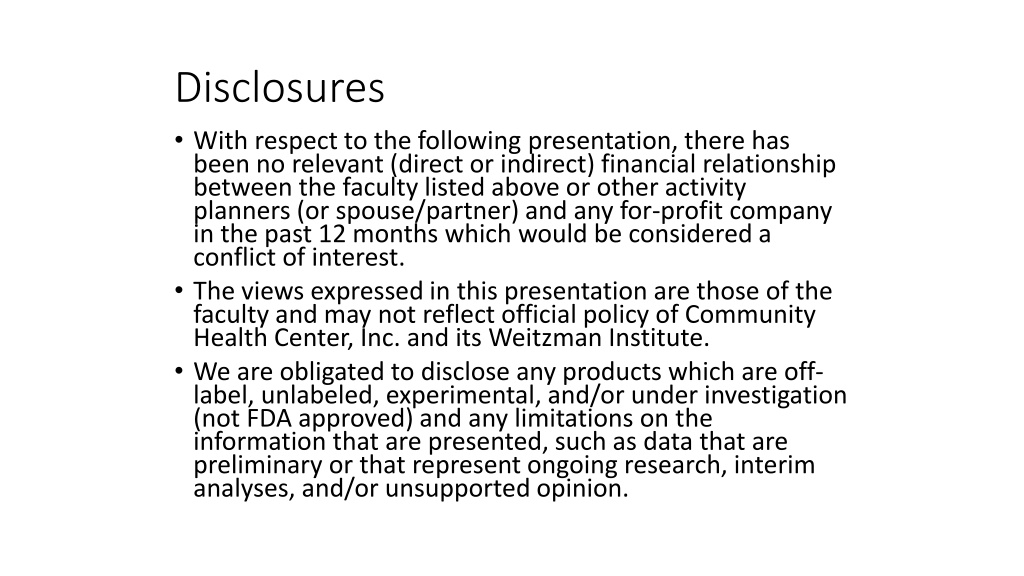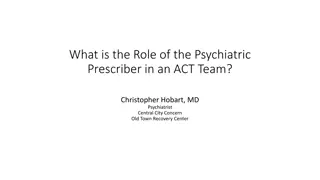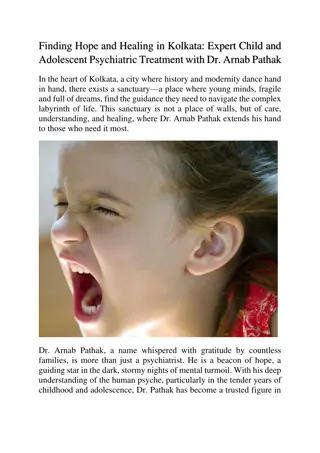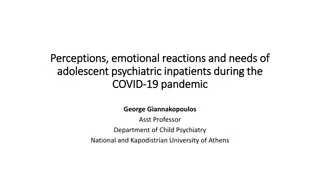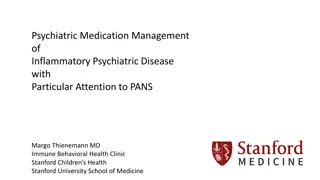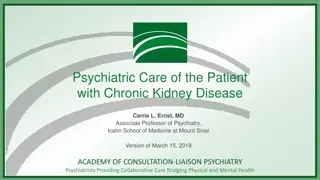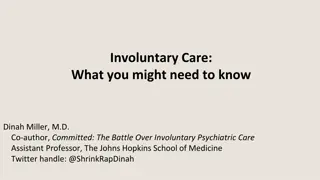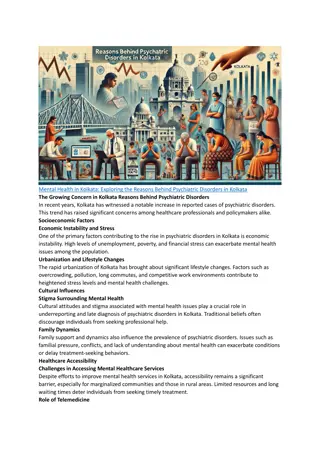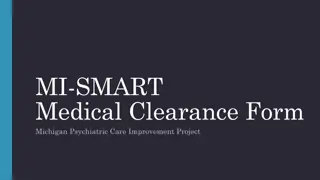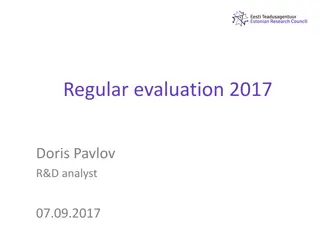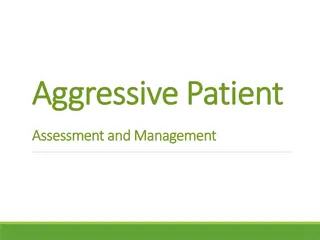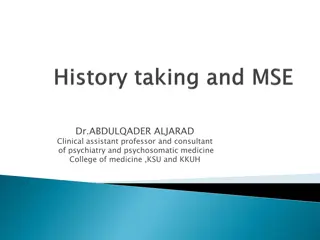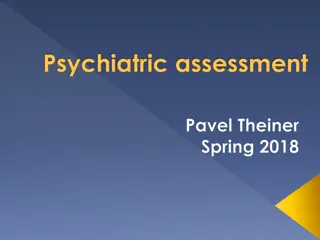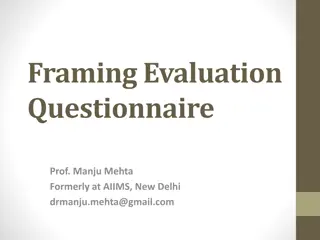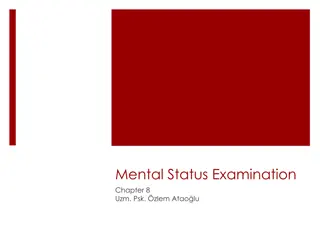Psychiatric Evaluation Process Insights
This presentation provides valuable insights into conducting psychiatric evaluations, including tips on referrals, team processes, interview techniques, and obtaining usable data. The speakers emphasize the importance of thorough preparation, flexibility, and understanding individual nuances during evaluations. Key points cover setting agendas, recognizing behavioral cues, using metaphors for communication, and addressing emotional nuances indirectly. The content focuses on practical strategies to gather comprehensive information and build rapport with patients effectively.
Download Presentation

Please find below an Image/Link to download the presentation.
The content on the website is provided AS IS for your information and personal use only. It may not be sold, licensed, or shared on other websites without obtaining consent from the author. Download presentation by click this link. If you encounter any issues during the download, it is possible that the publisher has removed the file from their server.
E N D
Presentation Transcript
Disclosures With respect to the following presentation, there has been no relevant (direct or indirect) financial relationship between the faculty listed above or other activity planners (or spouse/partner) and any for-profit company in the past 12 months which would be considered a conflict of interest. The views expressed in this presentation are those of the faculty and may not reflect official policy of Community Health Center, Inc. and its Weitzman Institute. We are obligated to disclose any products which are off- label, unlabeled, experimental, and/or under investigation (not FDA approved) and any limitations on the information that are presented, such as data that are preliminary or that represent ongoing research, interim analyses, and/or unsupported opinion.
Conducting the Psychiatric Evaluation Emily Farb Marnie Flynn
Referrals Team referral process Preparing for an eval Chart review School records Collateral Have a plan, set agenda- be ready to test drive your hypotheses, but also be flexible Strategy- symptom clusters/fly over method Know inherent temperament/disposition trends and trajectories Arrested developments, trauma Remote vs in-person Consider developmental age
Interviewing- NOT a checklist Explain the process How do we enter Materials Who to address first Never launch into behavioral issues/presenting problems No jargon What to watch for (beyond MSE checklist!) How do they come in, who sits where, interactions etc Lets do some examples: 14yo moody/angry/shut down teen 6yo anxious
Getting Usable Data REMINDER: NOT VOLUNTARY USING THE 3RDPERSON AND METAPHORS ASK FOR OPERATIONAL/OBECTIVE DETAILS IN ADDITION TO SUBJECTIVE DETAILS UNLESS OFFERED, STAY AWAY FROM DIRECTLY ASKING ABOUT EMOTIONS AND CHECK FOR SHARED DEFINITIONS Must use back door or else they will shut down takes me forever to fall asleep / ive had SI, but they go away fast THEY WILL ENDORSE WHAT THEY HAVE HEARD PARENTS SAY AND INTEGRATE IT INTO THEIR REPORT ***WATCHING CHANGES IN ACTIVITY LEVEL AND TYPE, LEAVING THE ROOM, ATTENTION, AMOUNT OF VERBAL CHANGES (TONE, MATURITY, AMOUNT, ETC WHILE PARENT IS TALKING) ***PLAY IS DOMINANT LANGUAGE KNOW IF CHILD IS HUNGRY, TIRED AND DID/DID NOT TAKE THEIR MEDS AND WHAT TIME!!! THEY ARE FEARFUL (EXPRESSED IN DIFFERENT WAYS) SO MAKE SURE YOU REVIEW WHAT THE PURPOSE IS (NO SHOTS) and WHAT THE PLAN FOR THE EVALUATION IS SEQUENTIALLY ***START WITH EASY, PLEASANT STUFF: FAVORITE ACTIVITY- THINGS YOU LIKE TO DO BEST SUBJECTS-RECESS IS VALID! MENTION ART, MUSIC, SPORTS PETS? LET THEM ASK ABOUT YOURS
Continued DO NOT ASSUME THEY SAY THINGS IN THE SAME SPIRIT AS ADULTS: Instead of facts being verbalized and handed to you, you have to observe, investigate and synthesize SUICIDAL OR HOMICIDAL STATEMENTS MAY JUST BE EXPRESSIONS OF ANGER/MAD BUT IF THEY DO GO TO ED AND SAY THEY ARE NOT SUICIDAL, THIS MAY CHANGE ONCE THEY LEAVE THE ED! Pay attention to context TIME IS PERCEIVED DIFFERENTLY, SO TIE TO DAY/NIGHT, SEASONS, HOLIDAYS, SCHOOL PATTERN OR KNOWN EVENTS When inquiring about timelines/duration-anchor it to something if a time segment is offered spontaneously- do take it seriously TEENS: GENERALLY ASK THEM NOT TO TRUST ME TELL THEM IT IS THEIR CHOICE TO SHARE OR NOT- can say none of your business! ALWAYS TRY TO OFFER TIME ALONE IN CASE THEY ARE NOT COMFORTABLE WITH PARENTS IN ROOM
Presenting problem/HPI Sx at home/school/community NOTE Changes from baseline NOTE relevant change in life/events Frequency, duration, intensity In their own words and in parents words. Then details, across each domain, separately eating sleep attention/concentration hyperactivity worries, panic, sensory, compulsions/obsessions/rituals, phobias mood mania aggression abuse Trauma sx flashbacks, memory lapses, dissociative sx, arousal ah/vh SI, SIB HI With peers substance abuse, risk behaviors, promiscuity, legal DCF involvement- if relevant
What is the difference between HPI and PP? You do not necessarily need to create a separate section but make sure you comment on the following- when it started, patterns, how long, how intense, triggers, what improves it, where it happens, other things that accompany it
Psych Psych hx hx treatment types length response ED visits 211/911 PHP/IOP Inpatient diagnoses medications: what tried, if used as RX, responses good and bad, idionsyncratic Getting med rec: Must use TE DROP-DOWN Pharmacy Assistance
Developmental Hx Specifics: for Eval in our setting, the must haves prenatal Perinatal Labor, delivery, complications and status at birth Attachment/temperament Sensory Play Milestones- AT LEAST WALKING, TALKING, TOILETING Separation School preschool, peer and teacher interaction, learning, attention/concentration/hyperactivity/impulsivity, held back, accommodations DCF/systems involvement/TRAUMA- PHYSICAL AND SEXUAL ABUSE/NEGLECT Social friends, gender, comfort, romantic sexuality preference, gender identification Sexual abuse, physical abuse, neglect, trauma exposure Caregiver disruptions, losses, moves Enjoyed activities Hated activities what they think about after HS Extracirricular activities 3 wishes
Family Structure/Function Structure: who is present in home where other significant members are located Types of connections/relationships Deaths, incarcerations, presence, work, discipline, organization type Structure of the physical home shared rooms, privacy, etc Function: Roles who has psych hx and what dx, what meds and responses, substance, legal, medical illnesses, medications, diagnoses Custody and parental rights Culture/ethnic identification Beliefs/preferences immigration status Exploring family psych history *in detail* confirm genetic loading, consider intergenerational trauma (may confound reported psych DX) FAMILY HISTORY OF SUDDEN CARDIAC DEATH FAMILY HISTORY OF GENETIC PROBLEMS
Medical developmental delays chronic or acute conditions TBIs Seizures Anemia abnormal bleeding lead exposure Asthma recurrent ear infections recurrent strep high fevers exposure to bacterial/viral infections lyme/tic borne Rashes cardiac hx-murmurs, chest pain with activity fainting/dizziness/near syncope Autoimmune eating/elimination issues enuresis/encopresis Puberty/menses Pain- somatic or otherwise Hearing/vision. allergies/rxn Surgeries/hospitalizations, include age See ROS Handout for more details
Mental Status Exam Purpose- diagnosis, baseline for changes in functioning, and evaluation of treatment Interpreting from the non-verbal Use narrative form Drawing (self portrait, family, favorite activity) Usually involves comment(s) on changes observed across interview Someone reading the write up should be able identify child in waiting room
Appearance A. B. C. D. abuse, self-mutilation, evidence of injury, musculature E. Dress: message of style, appropriateness for site and weather conditions, gender orientation, flamboyance, neatness/grooming, age-indicated, tattoos, piercings F. Gait and posture: smooth, clumsy, sitting, walking, posture G. Gestures: intensity, expressiveness, nervous behaviors Face: Symmetry, dysmorphism, scars, lines, expressiveness/expression Eyes: clarity, strabismus, gaze, glasses, eye contact Head: size relative to body, hair coverage, shape Body: dress, nutritional status, hydration, skin, grooming, marks:
Motor/Motility A. Quality: smooth, jerky, random, purposive, agitated B. Quantity: hyperkinesis, persistent vs. intermittent, when, how long, changes in, control of C: Type: Motor or Vocal tics, fidgeting, overflow motor, Stimming D: Balance: Hop on each foot, walk on line, stairs, eyes closed E: Coordination: laterality, overflow, ball catch and throw, use of supports Gross vs. Fine Motor: pick up sticks, choice of drawing material: 3-4 years can draw a O 2-5 years can draw + 6-7 years can draw: SELF, FAMILY, PREFERRED ACTIVITY
Speech/Language SPONTANEOUS? BILINGUAL? Quality: smooth, clear, expressiveness, tone, volume, modulation, articulation, coherence Quantity: pressured, speed, poverty of speech, pauses: stuttering (normal up to 3-4 years), cluttering, monosyllabic Receptive capacity: follows commands, directions Expressive capacity: spontaneity, vocabulary Comprehension Content: echolalia, word salad, changing neologisms, idiosyncratic nonsense Writing/ Reading: reversals (normal till age 7), quality, fluency Nonverbals: congruent
Intellectual Functioning Estimate to norms: borderline, low, average, high, superior Creativity Spontaneity General Knowledge: ask time, money, new information Academic: grade, like school, grades, least/ most favorite book/story- what it is about Comprehension: ask for a joke, tell a joke Social Intelligence: travel, what to do in situations Attention: distractibility (to what) Concentration: count back by 3's Frustration Tolerance/ Persistence Organization Body Parts: 3 years- face and limbs 5 years- wrist, ankles, elbows and knees 7 years-jaw, temple, forearm, skin Memory/ Time- a poor measure
Thinking and Perception LOC Body- boundaries, depersonalization, derealization, self concept Thought content- themes, delusions, grandiose Hallucinations- can only distinguish after age 3-4 Obsessions Compulsions Phobias SI/HI Poverty of content Magical thinking persisting after age 8 or 9
Thought Process Loosening of association- rapid shifts without logic Flight of ideas- some connection but rapid/ racing Tangential: never gets to the point Circumstantiality: gets to the point but digresses Incoherence: word salad, vagueness, punning, clang associations, neologisms, echolalia Perseveration Thought Blocking- interruptions Judgment: what would you do if... Insight: level of understanding in situations
Mood and Affect Mood: internal/ subjective Quality: client's terms, describe, intensity Duration: how long, patterns/ cycles Pervasiveness: in what situations, triggers Affect: objective by observer Predominant affect: anxiety, happiness, sadness etc. Range: constricted/ full Appropriateness: relative to discussion Quality: blunt, flat, constricted, expressive Intensity: match ? content Progression: note changes in affect lability
Manner of Relating A. Separation from caretaker B. Degree of Independence C. Style: flamboyant, stoic etc. D. Passive/ active: introvert/ extrovert E. Eye contact- beware culture F. Personal space G. Manner of approach H. Approval/ attention-seeking I. Age level: regressed, precocious J. Aggression K. Sexualized behavior L. Limit testing M. Curious vs. aloof/disinterested N. Coping behaviors O. Objects: peers, pets, transitional objects
Character of Play, Fantasies and Dreams A. Themes B. Persistence / repetition C. Level of development D. Age of appropriate E. Rules: ability to follow, understand, cheating (abnormal > 8 yrs. old) F. Organization G. Creative vs. stereotyped H. Open/close: how they start/finish I. Gender "appropriate" J. Affect: especially aggression - random, goal-directed, contained K. Tools to use: 1. Ages 2-5: blocks, animals, sorting, house Ages 5-7: animals, house, playdoh, checkers, drawing, puppets Ages > 8: games, balls, drawing L. Flow: changes in themes, play disruptions, requests to leave
Assessment of Risk *How to ask across ages SI HI Psychosis Substance abuse remind them of confidentiality and importance relative to medication interactions
Formulation CONCISE summary of case in light of information available Captures the ESSENCE and PORTRAIT of the patient Distinguishes Primary versus Secondary Issues Weighs the variables and correlations Clarifies central issues and conflicts with an eye to SOURCE Guides treatment Predicts outcome and possible trajectories
Formulation Continued Contents Predisposing factors: genetics, constitutional/temperament, environmental exposure Precipitating factors: stressors, developmental, changes, physical conditions, losses Perpetuating factors: what maintains Protective factors: individual strengths, family, support systems, intelligence, interests
Formulation Continued How impaired in functioning in different domains Is disturbance intrinsic or reactive What is the organic component What is the range of symptoms: encapsulated or pervasive Are symptoms transient, cyclical, chronic, consistent or changeable What psychosocial factors have impacted the picture and WHEN What psychosocial factors are continuing to impact What developmental tasks are they working on What is their range of coping strategies and defense structures
Formulation Continued Structure Summarizing statements: include demographics (race, ethnicity, age and gender) why this patient, why now and most salient features Description of Non-Dynamic Factors: genetics, environment, pre and peri- natal, medical issues, LDs, IQ Psychodynamic Explanation of central conflicts and modifying variables: loss, abandonment, TRAUMA, Caregiver status, incarcerations, identity themes, changes in family, migration/cultural or language issues, stage of development ACCOUNTING FOR THE DIFFERENTIAL: WHY THIS AND WHY NOT THIS Strengths/weaknesses Predicting responses to therapeutics, /PROGNOSIS WITH AND WITHOUT INTERVENTION
Formulation Continued DO NOT INTRODUCE NEW MATERIAL IN THE FORMULATION DO NOT JUST REPEAT OR RESTATE DATA. YOU HAVE TO SYNTHESIZE THE DATA!! CREATES A MAP/RUBRIC IT SHOULD READ LIKE A STORY AND IS NOT LINEAR
Plan KIND OF TREATMENT LEVEL OF CARE AND WHY IN WHAT ORDER***** FOR SHORT GOALS-STABILIZATION/RESPITE, ETC. FOR THE LONG-TERM GOALS NONPHARMACOLOGICAL THERAPY COLLATERAL TREATMENT: OT, PT, PSYCH OR NEUROPSYCH TESTING-for what purpose MEDICAL NEEDS: MRIS, NEUROLOGICAL, ENDOCRINE, RHEUMATOLOGY, ETC.for what purpose SYSTEMS/RESOURCES PHARMACOLOGICAL: sequence, purpose-disorder or symptom relief PLAN FOR RETURN
Plan Continued Make sure the plan makes sense Make sure the plan is DO-ABLE!!!! Make sure there are no barriers Make sure the family is in agreement Make sure you are not overloading the system and compromising the viability and sustainability
Pearls, Dos and Donts Do not use medical/mental health vernacular Do not start with how have you been feeling? Use stories and metaphors, related to their interests Use holidays and seasons for timelines One question at a time Be direct with risk assessment Consider developmental stage and cognitive functioning Engage playfully in any way you can Check for understanding-ask for a bit of feedback LOOK/LISTEN and even use you olfactory sense Explore the whole picture Balance story of parents, kids, schools and other collateral informants-include contexts Know yourself-we are likely to have countertransference/judgment laden responses
Pearls, Dos and Donts Check for understanding-ask for a bit of feedback Screen for reactions-including you peripheral vision STAY OUT OF YOUR HEAD KNOW NORMS for age and cultural framework to understand where and how they are off the track MIRROR Be present and open. Be expert, but first be humble. You are not an expert around their experiences FOLLOW THEIR LEAD-KIDS AND PARENTS Compete with parents-our job is to help them to help their kids
Pearls, Dos and Donts Don t Judge Don t overfunction (do not do more that they are willing) Don t be a bleeding heart DON T TALK TOO MUCH/DON T TALK TOO SOON-GET THE PICTURE DON T GET OVERFOCUSED OR DISTRACTED BY CONTENT RATHER THAN PROCESS People unfold when they feel safe and may DOORKNOB important information. There are always hidden agendas-mostly unconscious, but not always. Don t assume that the story once told will stay consistent. Don t keep going if you are digging a hole Don t be afraid to be wrong and if you are-TELL THEM
